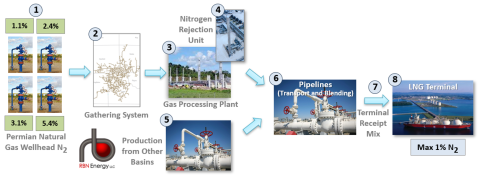There’s a lot of nitrogen: it’s the seventh most common element in the universe, and Earth’s atmosphere is 78% nitrogen (and only 21% oxygen). And there is certainly nothing new about nitrogen in the production, processing and delivery of natural gas. That’s because all natural gas contains at least some nitrogen. But lately, the nitrogen content of some American natural gas has become a real headache, and it’s getting worse. There are two things going on. First, some counties in the Midland Permian Basin produce gas with an unusually high nitrogen content, and those same counties have been Midland’s fastest-growing production area in recent years. Second, there is the LNG angle. LNG is by far the fastest growing sector of US gas demand. LNG terminals here in the US and US LNG buyers don’t like nitrogen one bit. As an inert (ie non-burning) gas, nitrogen reduces the calorific value of LNG and takes up space (decreases effective capacity) in the terminal’s liquefaction train. In short, nitrogen generally fouls the LNG liquefaction, transport and consumption process, which means that nitrogen is a considerably more problematic issue for LNG terminals than for most domestic gas consumers. So as the LNG sector increases as a fraction of total US demand, the nitrogen issue really comes to the fore. In today’s RBN blog, we’ll explore why high gas nitrogen is happening, why it’s important, and how bad it could be.
Let’s start with the basics. Figure 1 shows how nitrogen gets from the wellhead to the LNG terminal, with the numbers on the chart matching each bullet below. This is a generalized example, but it is more reflective of the Permian-Midland gas production, a significant portion of which reaches the Texas Gulf Coast.
- Nitrogen content at the wellhead varies significantly by geography and geology. One well may have 1% nitrogen, while another down the road may have 5% or more. Percentages shown are representative of wells in the highest nitrogen zones of the North Midland Basin.
- Wells with a wide variety of nitrogen content feed common collection systems, which in effect become the first line of defense in the nitrogen mitigation process. The higher nitrogen gas is mixed with the lower nitrogen gas to produce a gas mixture that generally reflects the average nitrogen content in the area covered by the collection system.

Figure 1. Nitrogen flow from the wellhead to the LNG terminal. Source: RBN


